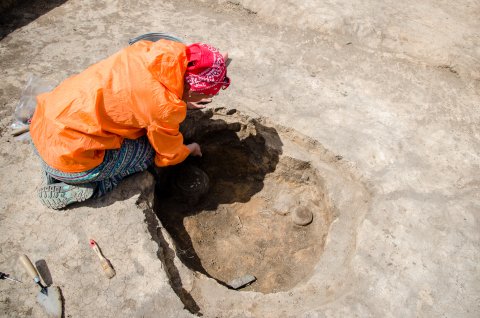SUSU students don’t only get their bronze summer tans laying on the white sands near the water, but also while working hard in practical training, like the students of the Faculty of History of the Institute of Social Sciences and Humanities, who have set off for an archaeological expedition to a site from the bronze age – burial mound #12 in the Kartalinskiy region.
They have 17 days of this practical training behind them, and this is just the beginning. Right now they are working on a small burial mound, where they have already found the bones of a newborn and a ceramic vase. Still ahead is the central burial area.
“Our task was to gradually remove the structure built over the graves, photograph them, and sketch them. Next we are expecting real discoveries. Today the students saw how ceramics and human and animal bones look and learned to distinguish them,” says the leader of the expedition, doctor of historical sciences, Andrey Epimakhov.

Here, students are gaining the skills they can’t receive anywhere else: cooking for 30-40 people over a campfire, living in a tent, and surviving unstable climatic conditions.
“The students are completing digs in a real archaeological site from the bronge aze, and this is the traditional venue for SUSU student practicals for many years. They participate in all of the stages of research. Academic practicals involve getting to know how archaeological monuments work and how the process of digging and research goes. Since they are directly involved in each stage, they understand what they are doing well. At the end of the practical training, they should all be qualified. It is important that the students understand what they are doing, how they are doing it, and, most importantly – why,” adds Andrey Epimakhov.
The students themselves are glad to spend their summer in such a unique way, learning something new and useful. In the future, thanks to this practical experience, they will be able to continue their scientific work in masters’ and postgraduate programs.

“I had the chance to complete my practical training in a museum, but I decided to see digs and finds first hand – where we came from and where we are going. Most of all I liked the chance to live outside of the city for a month in nature, studying science in this way. I found out how to work with soil, how to approach this scientifically, and even had a find – a ceramic shard about 3500 years old. After completing university, I’d like to become a historical researcher,” shared Roman Halimov, second-year student of the ISSH Faculty of History.
The expedition will continue for at least 1.5 more weeks, and before this time, the participants of the expedition will complete their study of the burial grounds, return it to its initial state, and the students will happily return home with tanned noses.






